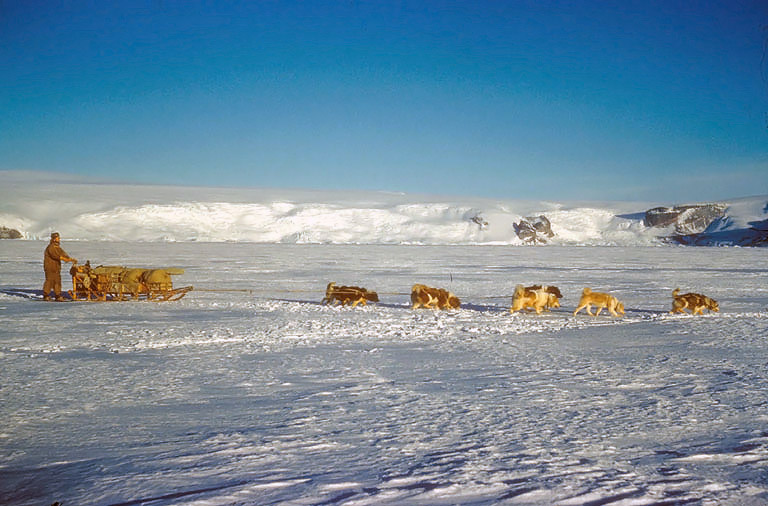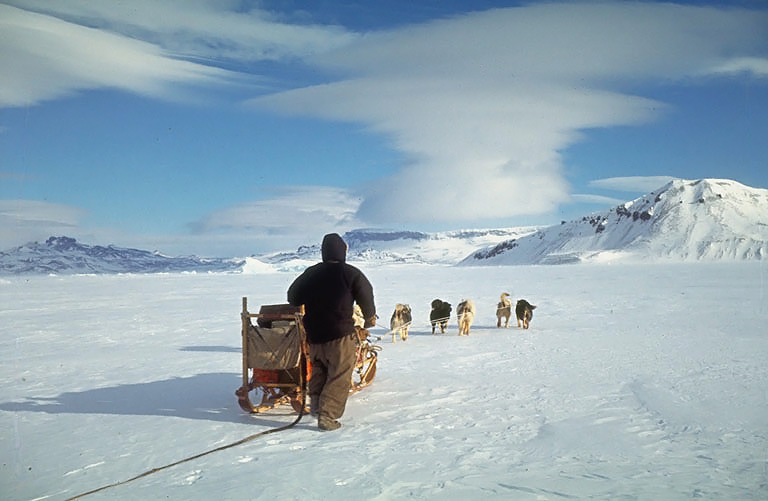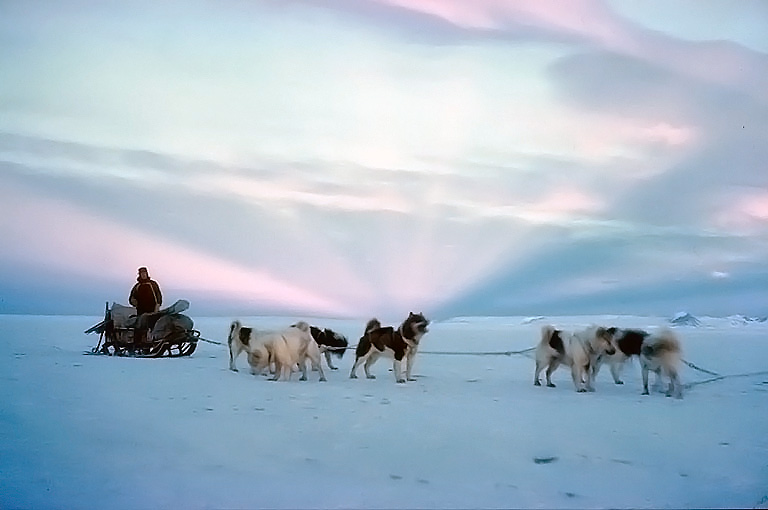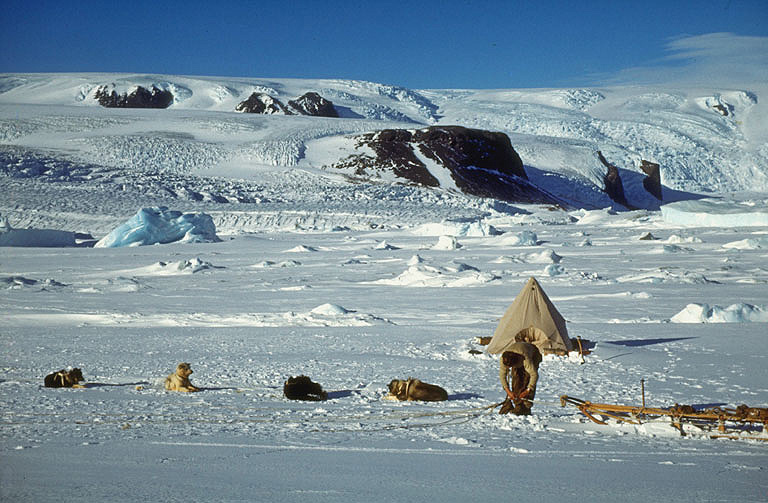Antarctic Dogs - Huskies - Pictures page 2
page 1
Pictures and words - Drummond Small
- Stonington 1971-72
|
The history of huskies in Antarctica
Huskies pulling sledges were the first effective form of transport in Antarctica, they allowed for the early exploration of the continent when men and dogs were mutually dependent on each other for their very survival.

Dogs this way came... The pictures shows dog tracks initially made in soft snow, the dogs paws compressed the snow below the surface. Then along came an Antarctic blizzard and blew away all the previous snowfall except where it had been compressed by the dogs paws - leaving raised prints. The longer raised patches are likely made by the sled runners in the same manner.

Toste, a strong male - Many of the dogs used in Antarctica came from Canada, originally bred by the Inuit as hard-working cold weather multi-purpose companions. As a breed, they are thought to be over 1,000 years old, perhaps as much as 2,000. There are many local breeds and varieties of such dogs in and around the Arctic.
These dogs are as tough as you'd expect for an animal bred for such an extreme environment. They are intelligent, alert, affectionate and develop deep and loyal bonds with their owner/drivers.
They are large powerfully built dogs, weighing around 30-40 kg (65 - 85 pounds) for males and 20-30 kg (40-65 pounds) for females. Height at the shoulder varies from 50 cm (20 inches) for smaller females up to 70+ cm (28 inches) for large males. They have a thick neck, broad chest and strong, thickly muscled legs. Their feet have dense fur and the thick double coat is completely weather proof. Surprisingly perhaps, they have relatively little body fat, instead, it is their fur that provides insulation - they suffer in warm environments being prone to heat stroke.

Huskies and camp - Dog teams were hard work for the team leader, as well as getting their food and making sure they had enough of it and on time, the dogs would need their winter quarters cleaning and then of course the was an awful lot of tummy tickling and generally making the dogs feel they were an important part of the pack so they gave it their all.
The dogs here have stopped and been staked out for the night. Each dog has some movement from a central line, but not enough to reach the next dog to avoid fights, such an arrangement is known as a "span".
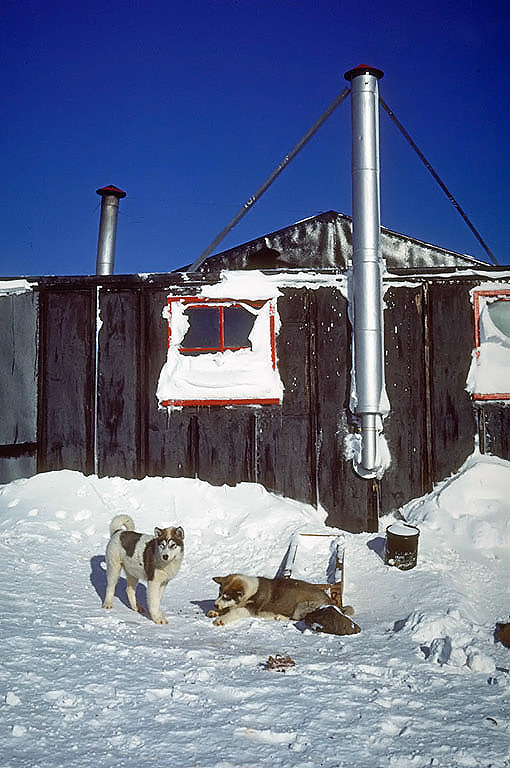
Dogs outside Antarctic base - Husky puppies were kept closer to the base until they were old enough and large enough to join the rest of the dogs on the spans and to be trained to sled pulling.
Antarctic dogs were bred in Antarctica with records kept as far as possible to ensure "outbreeding" so avoiding dogs that were related from breeding and so promoting inherited problems. Occasionally new dogs were brought in from Canada or Greenland to add diversity to the gene pool or dogs would be swapped between bases for the same reason.
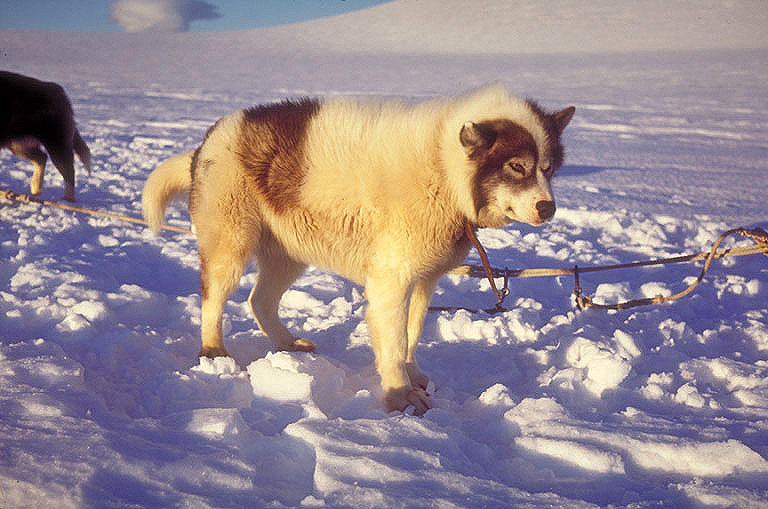
Moe - the youngest of the team. The hierarchy in a dog team is all important, the lead dog has to not only be the dog chosen by the human team leader, but he/she has to be respected by the other dogs. Huskies are first and foremost pack animals, they need a sense of belonging and order to feel happy and to function properly - when they do, they will literally pull the sled as hard as they can until their last breath.
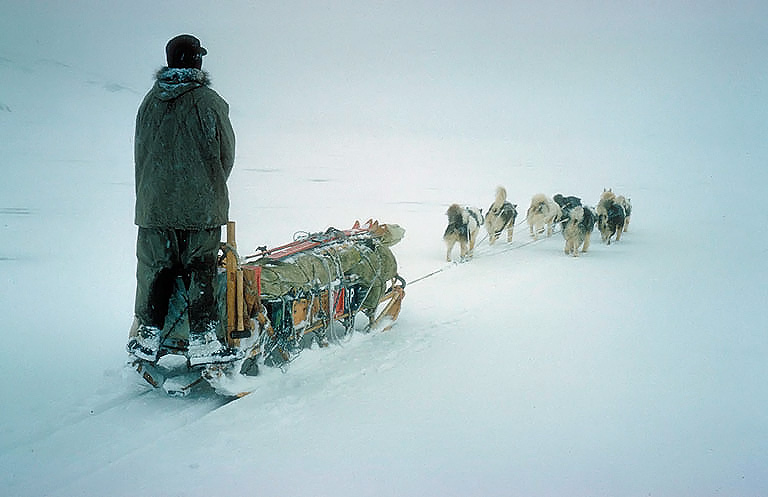
Setting off into the unknown - sledging in a white-out. Low cloud and a plain white landscape without any bare rock or other features gives "white out" conditions, sometimes likened to "travelling inside a ping-pong ball".
In such circumstances, the dog driver is relying on the lead dog to spot and react to any problems or dangers on behalf of the whole team and himself. The lead dog has to be an intelligent animal in such circumstances.
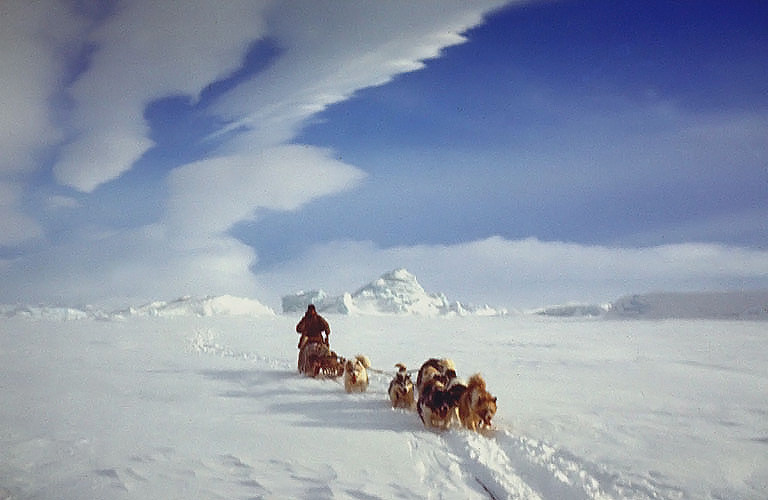
Under Antarctic skies - Soft surface snow and a bright sunny day lead to wonderful almost ethereal conditions. Self-contained travel without an internal combustion engine in sight.
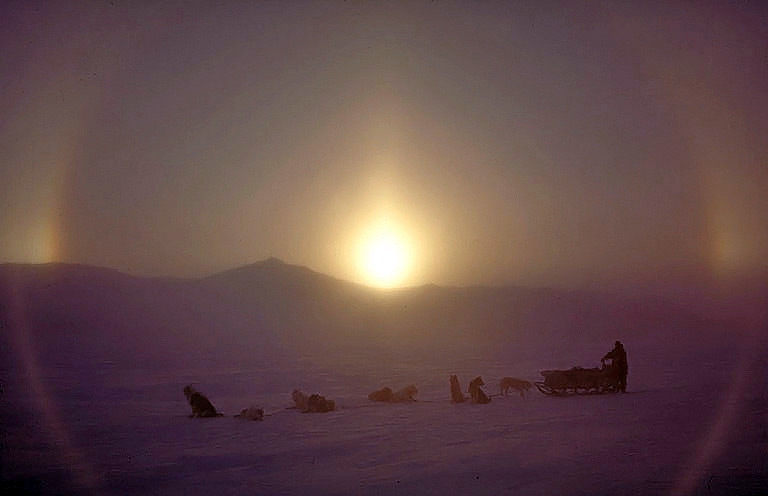
Solar halo - sundogs and sled dogs. The depths of winter in Antarctica can give conditions with lots of tiny ice crystals hanging in the air, these can give all sorts of atmospheric phenomena when the sun shines. The ring is called a Solar Halo and the two bright areas at the 3 and 9 o'clock positions are called Sun Dogs.
In more difficult conditions, the driver may have to walk or run alongside the sled, often manhandling it around obstacles and pushing it to start if the dogs can't manage to get it started on their own.

Wet running - Melting spring sea ice gives some pretty unpleasant travelling conditions.
The ice is still very thick and safe, but warmer days cause the snow and ice on the surface to start melting giving large melt pools. The good news is that the ice surface beneath the shallow water is usually very smooth, the bad news is that the water is icy cold and splashes up as you travel through it.
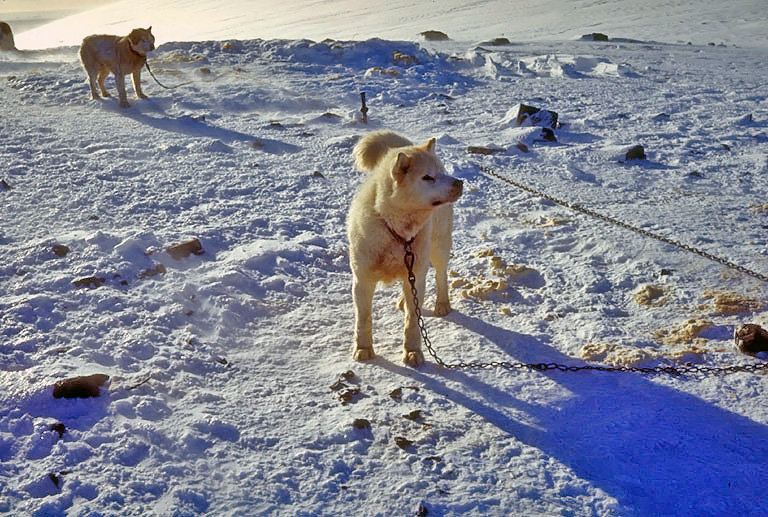
OK so where's dinner? - Margot - a flighty female. On the spans again. You get a good idea of the amount of movement the dogs get while staked out like this. Sled dogs while generally obedient when harnessed to a sled are notoriously badly behaved when not on any kind of lead - not responding to commands and taking great delight in running rings around anyone trying to catch them.
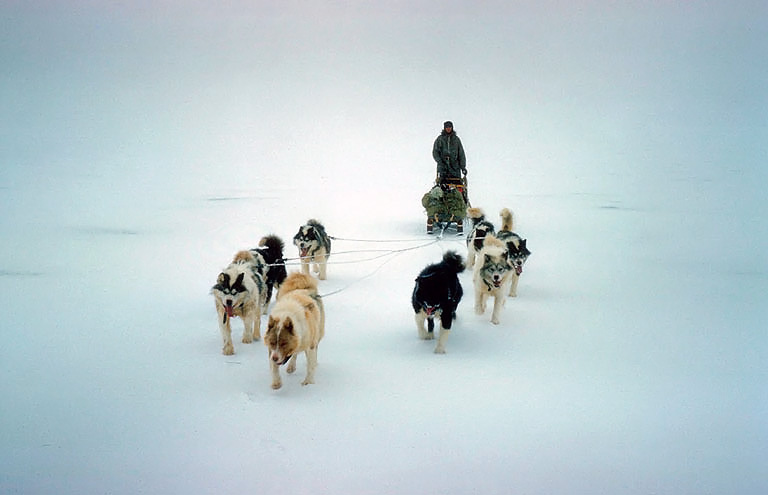
Low contrast - Fan trace. The trace is the name of the lines that connect the dogs to each other and also to the sled - as in this case it fans out - it's called, a fan trace.
The dogs each have a harness on that goes around their chest and shoulders with a ring over the back where the trace is clipped. At the end of the day, they can be easily unclipped from the sled and clipped onto the spans where they spend the night.
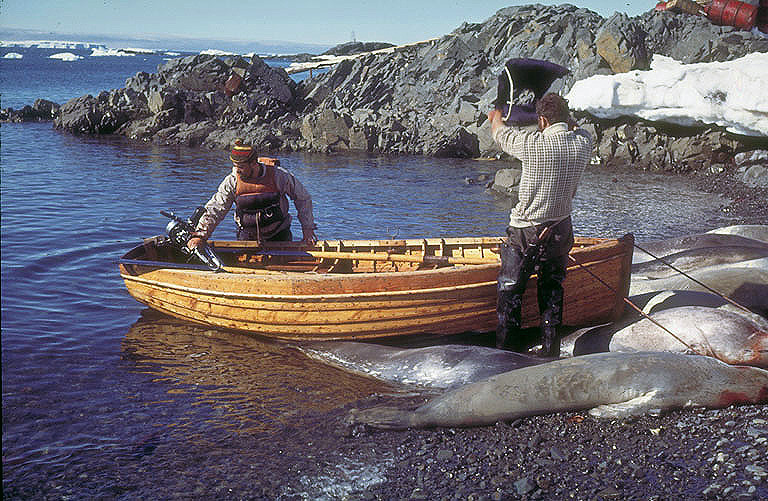
The price of dogs - Though Huskies might look like big soft fluffy balls of fun, like all dogs, they are carnivores and so need regular large amounts of meat, which however removed we are from the reality these days, comes from dead animals.
In Antarctica, the source of this meat was seals, mainly crabeater seals that had to be hunted (with rifle) by the "dog men". This was a job for the summer when seals were more plentiful, they would be stored through the winter and rationed to the dogs
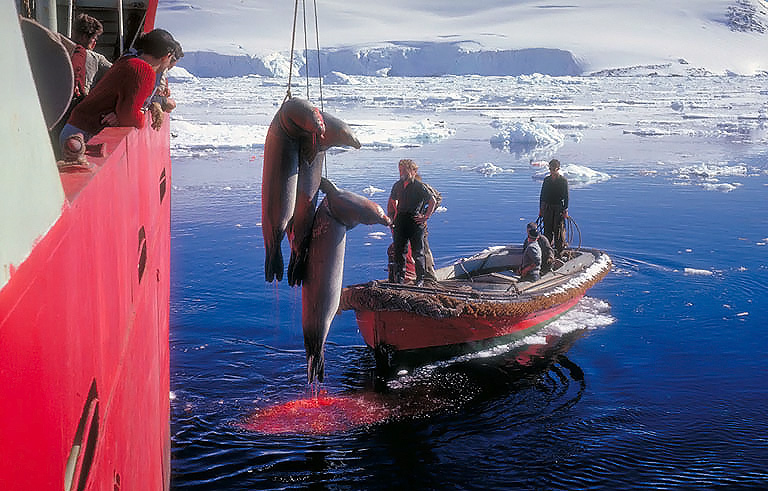
The price of dogs - 2. This may look very gory, but it was the best way of getting food for sled dogs in Antarctica. Crabeater Seals are very numerous, estimates are difficult to arrive at as they cover huge regions of Antarctica at a generally very low population density, there are around 15 million of them - every other seal in the world is a crabeater seal.
BBecause they are so widely and thinly distributed, crabeaters were never targeted by sealers unlike other seals that come together in large dense groups during the breeding season.
Cutting up seal on base was a major exercise involving a chain saw and axes. Cleaning the chain saw afterwards was a nightmare as it was caked with partially cooked seal mince. In most cases the meat was frozen solid when we fed the dogs which was blessing as it stank to high heaven when thawed in summer. The smellier the better as far as the dogs were concerned! Most eco-incorrect to admit nowadays but we used to take about 150 seals a year to feed the 160 or so dogs at Stonners (Stonington)
Drummy Small - Stonington 1971 - 73

A well deserved rest - Soft snow can hard work to travel across, this isn't very deep, but will still have an effect.
NNot as bad as the absolute worst surface ever - breakable crust. The surface appears hard, but when you put your weight on your forward leg the surface breaks and drops you the few inches to the harder surface underneath. The result is that you have to "walk upstairs" to walk on the level - all that extra energy just goes into uselessly breaking the snow surface
Husky pictures page 1 | The history of huskies in Antarctica
All pictures on this page copyright of Corel Corporation

